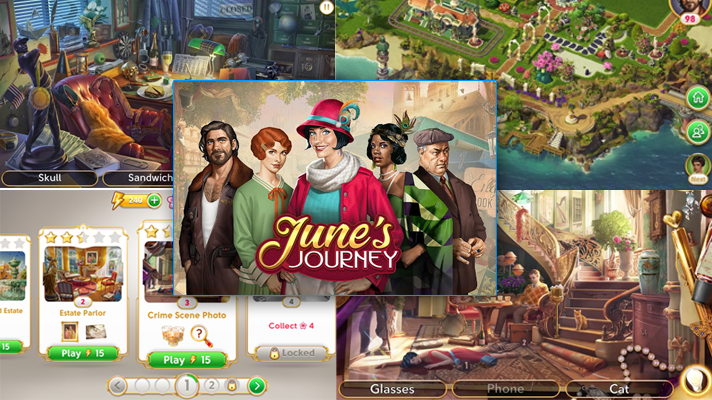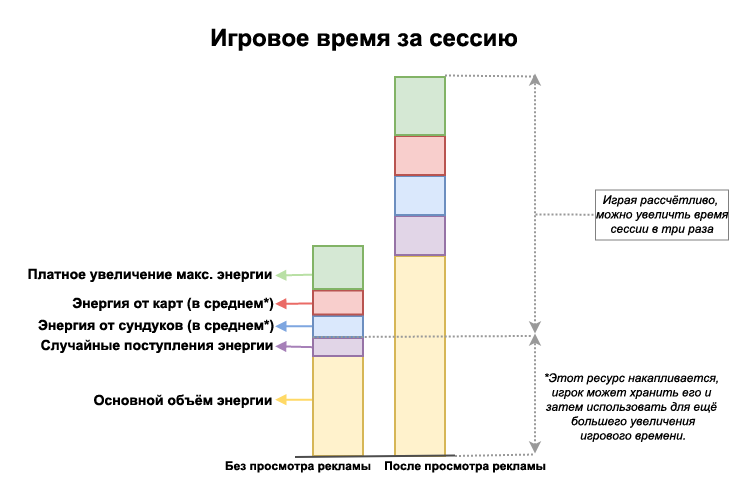Deconstruction: June's Journey Gaming Session
Translation of an article by game designer Philipp Zupke, in which he analyzes in detail the game cycle and original solutions in the design of the June’s Journey casual game session.

Philip Zupke
This is an article about how you can improve your game by giving players control over the course of the game session. As an example, I use the mechanics of June’s Journey, a free–to-play mobile hidden object game by Wooga. The game demonstrates how it is possible to provide players with a small but meaningful decision-making space. This allows them to build a meaningful strategy on how to spend game energy wisely.

SESSION TEMPO
Session design is a key element of the development of frituplays. Players should have fun in a predictable amount of time. This is what brings them back into the game again and again. And there are mechanics who just help in this.
Usually these mechanics work according to a certain schedule: after some time, missions are opened, energy / health is restored, the farm gives a new harvest. This is the most important thing in the “one bite” pleasure that mobile freeplay games give.
JUNE’S JOURNEY SESSION DESIGN FEATURES
June’s Journey has a simple power grid. You spend energy on passing scenes with the search for objects. The energy is replenished over time. You play until it runs out, after which you wait or purchase additional energy for money.
After a couple of days of playing, I saw that I could control my energy consumption. The player has several sources of replenishment of the energy pool at once, access to them can be obtained during the game or for money. The most important thing is that reserves of additional energy can be stored and used whenever you want.

As developers, we should strive to ensure that our games allow users to feel smart. And June’s Journey manages to do this due to several mechanics, which I will consider below.
CHESTS
Chests are given out as a reward for each “star” that the player receives. Stars accumulate when you repeatedly pass one level (scenes with the search for objects). When a level has earned five stars, it is completely passed. Chests contain Energy, Character Cards, and Resources needed to advance through the story. This content is generated randomly. Players can also buy chests for money.

Giving out these chests as a reward for completing the game is a smart decision. I think they are the basis for the monetization of June’s Journeys. Having made the chests part of the main game cycle, the developers teach players to use them regularly. After getting used to this and realizing the value of the chests, players may want to buy additional ones for real money. And it will be a conscious choice, not an emotional purchase.
But the key aspect of the mechanics of chests is that they are stored in inventory. The game does not reward the contents of the chests immediately, and the players decide when to open them. Users will do this when they feel that they need to take a risk for the opportunity to get additional energy – especially since the chances of getting it through the chests are quite high.
PROMOTIONAL VIDEOS
Most successful freeplay titles use promotional videos – after all, players like it when they don’t need to spend money on the game. However, the revenue from each viewing of such videos is very low. Therefore, in most games, stimulating promotional videos are embedded in the main game cycle. And in June’s Journey, video advertising is used very effectively.

For watching the commercial, the player receives a bonus: in the next half hour, he spends 33% less energy on launching the next level. Taking into account the energy bonuses that the player will receive for additional minutes of the game, this increases the session time from ten to twenty minutes. For a user who wants to feel that he is playing with his mind, such a solution becomes almost a necessity.
And besides, it’s also a kind of commitment on the part of the player. Having spent their time watching a promotional video, players thereby commit to playing until their energy reserves are completely depleted – so that the bonus received can be used to the maximum.
With the help of such mechanics, the game not only receives revenue from advertising, but also increases game time, and this is always a plus (unless the game has run out of content).
CHARACTER CARDS
Character cards can be obtained from the aforementioned chests. They are another resource included in the main game cycle. Cards accumulate in the pool, and when all the cards of one character are collected, the player needs to assemble a puzzle. As a reward for this, the player receives a one–time bonus – to restore all energy at once at any time. This is an interesting additional mechanic that also reveals the plot – with the help of these cards, the player is told more about the heroes of the story.

RANDOM ENERGY BONUSES
From time to time, the game simply rewards the user for completing levels with a small amount of energy. But this mechanic does not work for the player’s autonomy – on the contrary, I think it adds ambiguity about the length of the game session, which will not necessarily appeal to all players.
Yes, there are some players who will be happy with any crumb of energy that will allow them to play longer. But for other players, these uncontrolled flows of additional energy can cause irritation and fear of not using this bonus. But there are probably more players of the first type, so in general this is quite a viable mechanic – although I think there is room for development and adaptation to the interests of other types of players.
INCREASING THE MAXIMUM ENERGY
This ridiculously expensive upgrade allows players to permanently increase the maximum amount of energy and thus the number of missions that can be completed before the end of the session.

THE PERFECT SESSION
That’s how all these mechanics are integrated into the game economy, and in most cases they are activated at the will of the player. Each of these mechanics is included in the main game cycle in a slightly different way, aimed at different game situations and different types of players.

The power of these features is obvious if we consider them as a whole system. This system allows the player to customize the session for himself, to make it “perfect”. Players collect cards and chests, launch promotional videos – and now they are creating a long and encouraging session for themselves. It is impossible to overestimate the importance of the fact that players can use mechanics to plan and achieve similar game situations.
conclusion
By giving players control over these peripheral systems, the game also transfers the right to control the length of the session. The idea of prolonging gameplay by rewarding the player with additional energy is not new. But in games, every detail is important. And at first glance, minor changes in the mechanics can seriously affect what the gaming experience will be like.
Respect for the players
In many other games, energy reserves are replenished as a reward for passing, for example, when levelling up. However, I believe that this is not necessarily the best option for mobile casual games. After all, we never know what situation the players are in. Maybe they want to play a short session for two to five minutes and are not ready for such “gifts”. And then the gift turns into a curse: users may feel that they are pointlessly losing the game bonus.
Reward and expectation
Players earn session extensions for completing game content. To play to the end of the stage and get a reward is already an integral part of the games. But the June’s Journey system sends some of these awards to the reserve, which players can use whenever they want. They can postpone the use of some rewards for later.
Autonomy
Games should provide players with some autonomy. This is the cornerstone of success. And in casual games, it is especially difficult to include mechanics that will allow players to make decisions. Systems that provide a high level of autonomy are usually quite complex – for example, crafting, a technical tree, a skill tree, a narrative with several branches. But June’s Journey is an example of a system that gives players a little freedom, expands their capabilities, but remains simple for a casual audience.
Also on the topic:
- Analysis of the game: Vegas Words – Downtown Slots
- Deconstruction of Merge Town!: the Heyday of the hyper-casual genre
A source: Gamedesignstuff